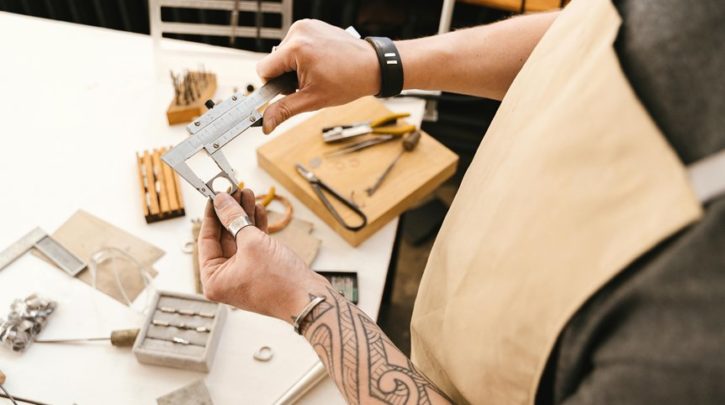When choosing a digital caliper, you need to weigh several key factors, including accuracy, durability, and hidden costs that might affect long-term value. Not all calipers deliver the same precision, and cheaper models may compromise on build quality, leading to inconsistent measurements. Additionally, maintenance expenses like calibration and battery replacement can add up. Comprehending these elements will help you select a tool that meets your specific measurement needs without unexpected drawbacks.
Understanding Caliper Accuracy Specifications
Although caliper accuracy specifications often seem straightforward, grasp of their practical implications is essential when selecting the right tool.
You’ll notice calipers claim accuracy to 0.01 or 0.001 inches, but real-world performance depends on caliper calibration and measurement techniques.
Testing with a 123 block reveals brand differences; some, like Hardell and Insiz, maintain precise readings across lengths.
Depth and groove measurements vary too, influenced by tip design.
Even budget options like Adoric can deliver reliable accuracy at common points.
Appreciating these nuances helps you choose a caliper that fits your precision needs effectively.
Comparing Budget and Premium Caliper Performance
When comparing budget and premium calipers, you’ll notice differences in build quality, smoothness of movement, and measurement consistency that directly impact usability and accuracy.
Budget caliper features, like those found in the Adoric and Pittsburgh models, often include gritty movement and inconsistent readings, which can reduce reliability.
In contrast, premium caliper benefits include smoother operation and tighter fitting parts, as seen in brands like Quinn and SNF, offering greater measurement consistency.
While budget options may perform well at specific measurements, premium calipers generally provide more dependable accuracy across varied dimensions, making them preferable for precision tasks.
Material and Build Quality Considerations
Material and build quality play an essential role in the performance and durability of digital calipers.
When evaluating material options, stainless steel models, like the Kinup calipers, offer superior corrosion resistance and sturdiness compared to plastic alternatives.
Build quality also varies considerably; premium brands such as Sterret and Matoyo use higher-grade materials and precise manufacturing, guaranteeing longevity.
In contrast, budget options like Adoric and Pittsburgh often suffer from gritty movement due to inferior materials.
Heavier calipers usually indicate better construction, contributing to stability and consistent measurements.
Prioritizing quality materials and build guarantees reliable, long-lasting calipers for accurate work.
Importance of Smoothness and Consistency in Operation
You need to pay close attention to how smoothly the measuring jaws move, as uneven sliding force can cause inconsistent readings.
When the sliding action varies, especially under different pressure levels, it directly affects the accuracy of your measurements.
Ensuring consistent operation helps maintain reliable results and avoids errors during your work.
Measuring Jaw Consistency
Smoothness and consistency in the movement of a caliper’s measuring jaws play a critical role in achieving accurate measurements.
When jaw performance is uneven or gritty, as seen in budget models like Adoric and Pittsburgh, measurement reliability suffers. These inconsistencies can cause force variances, leading to inaccuracies.
Mid-range calipers like Kinup offer smoother, more consistent jaw action, enhancing precision. High-end options such as Hardell combine accuracy with smooth operation, ensuring consistent results across multiple uses.
Choosing a caliper with reliable jaw performance helps you maintain measurement accuracy and confidence in your work.
Sliding Force Variance
Although many factors affect measurement accuracy, the consistency of sliding force during caliper operation plays an essential role.
Sliding force effects directly influence how smoothly the caliper moves and how steady your caliper grip feels. Budget models like the Adoric and Pittsburgh often show gritty movement and inconsistent sliding force, causing uneven caliper grip and less reliable operation.
In contrast, the Kinup and higher-end Quinn calipers deliver smooth, consistent sliding force, ensuring a stable grip and better control.
Choosing a caliper with minimal sliding force variance helps maintain consistent operation, improving your measurement experience.
Impact on Accuracy
Consistent sliding force directly affects the accuracy of your measurements by ensuring the caliper jaws maintain steady contact with the object.
Smooth, consistent operation reduces variability, especially in narrow grooves where outside measuring tips must be precise.
Budget calipers like Adoric often show gritty movement, causing inconsistencies, while mid-range models such as Kinup offer smoother action, improving reliability.
Premium calipers like Hardell achieve near-perfect readings, highlighting smoothness’s role in accurate measurement techniques.
To maintain precision, regularly follow calibration procedures and select calipers with steady sliding force, as this consistency is essential for dependable measurement results.
Evaluating Measurement Accuracy for Different Applications
When choosing a digital caliper, you need to compare accuracy standards based on your specific application requirements.
Some calipers perform well for general measurements, while others excel in groove or depth precision, which can be critical for certain tasks.
Comprehending these differences helps you select the right tool to guarantee reliable and precise measurements every time.
Accuracy Standards Comparison
Since accuracy requirements vary depending on the task, evaluating digital calipers involves comparing their measurement precision across different points and applications.
Different caliper types and measurement techniques affect how well a tool performs. For example, the Hardell caliper delivers precise readings at 1, 2, and 3 inches, making it ideal for tasks needing high accuracy.
Budget models like Adoric and Pittsburgh meet basic standards accurately at 1 inch. Javry calipers show slight deviations, suggesting caution for critical measurements.
Insiz excels in groove measurements, highlighting that specific tasks may require specialized accuracy considerations.
Application-Specific Accuracy Needs
Although all digital calipers measure length, their accuracy can vary considerably depending on the specific application you have in mind.
For general application specific tasks, budget calipers like Adoric suffice, though their precision requirements may fall short for detailed work.
Mid-range models, such as Javry, offer improved accuracy, ideal for tasks demanding higher precision.
When utmost precision is critical, high-end calipers like Hardell consistently deliver reliable measurements across various lengths.
Evaluating your precision requirements against these options guarantees you select a caliper that matches the accuracy needed for your particular application specific tasks.
Groove and Depth Precision
Accurate groove and depth measurements require calipers designed to handle these specific tasks with precision. Different caliper types offer varied effectiveness depending on your measurement techniques.
For instance, Insiz calipers excel in groove precision, ideal for narrow spaces, while Hardell calipers provide outstanding overall accuracy for depth measurements at standard increments.
Be aware that variability in outside measuring tips can affect groove measurement accuracy, highlighting the importance of caliper design.
Meanwhile, Adoric and Pittsburgh models reliably measure standard lengths, but Javry calipers may show slight depth deviations.
Choose your caliper type based on the specific groove and depth precision your application demands.
Battery Types and Their Impact on Longevity
Two common battery types power digital calipers: CR 2032 and LR44.
The CR 2032 offers higher capacity at 220 mAh, providing better battery longevity compared to the LR44, which has about half that capacity.
Choosing calipers with efficient power management features, like automatic shutdown or patented low-consumption technology, can further improve cost efficiency by reducing battery replacements.
Keep in mind that battery type and lifespan directly affect the total cost of ownership.
Hidden Costs: Calibration and Maintenance Expenses
When you own digital calipers, you’ll need to take into account the hidden costs that come with calibration and maintenance. Calibration frequency varies depending on the model; budget calipers often require more frequent adjustments, increasing maintenance costs.
Professional calibration services or purchasing calibration tools add to expenses. Battery replacement is another factor; longer-lasting batteries reduce overall costs.
Investing in higher-end brands can lower hidden costs because they typically offer better durability and require less frequent calibration. Comprehending these ongoing expenses helps you plan for the total cost of ownership beyond the initial purchase price.
Finding the Best Value: Balancing Price and Performance
Although price often guides your choice, balancing cost with performance guarantees you get the most value from digital calipers. Conducting a value comparison helps you identify options like Kinup, which offers smooth operation and durability at a reasonable price.
Performance review reveals that budget models, despite low cost, may deliver inconsistent results, while premium models provide precision but might exceed your needs. Brands like Worker present near-premium quality at lower costs, making them strong contenders.
Frequently Asked Questions
How Do Digital Calipers Compare to Dial Calipers in Ease of Use?
You’ll find digital calipers easier to use thanks to their user friendly features like clear LCD displays and quick zeroing. They also provide reliable measurement accuracy, making your tasks faster and more precise than dial calipers.
Can Digital Calipers Measure Both Internal and External Dimensions?
Yes, you can use digital calipers to measure both internal measurements, like the diameter of a hole, and external measurements, such as the width of an object. They’re versatile and user-friendly for various tasks.
Are There Waterproof Digital Calipers Available for Harsh Environments?
Yes, you’ll find digital calipers with waterproof features designed for harsh conditions. These models resist water and dust, ensuring accurate measurements even in tough environments, so you can rely on them without worrying about damage.
How Quickly Do Digital Calipers Display Measurements After Adjustment?
You’ll see measurements displayed almost instantly—thanks to advanced display technology, digital calipers offer rapid measurement speed. This quick response lets you take precise readings without delay, improving efficiency during your projects or inspections.
Do Digital Calipers Come With Warranty or Customer Support Services?
Yes, most digital calipers come with warranty options, and you’ll find customer service ready to assist with any issues. Always check the warranty length and support quality before buying to guarantee reliable help when needed.
Christina Pulluck helped bring Nebula Electronics from a a science and tech decision forum to a full-fledged news site by creating a new design and branding. She continues to assist in keeping the site responsive and well organized for the readers. As a contributor to Nebula Electronics, Christina mainly covers mobile news and gadgets.







